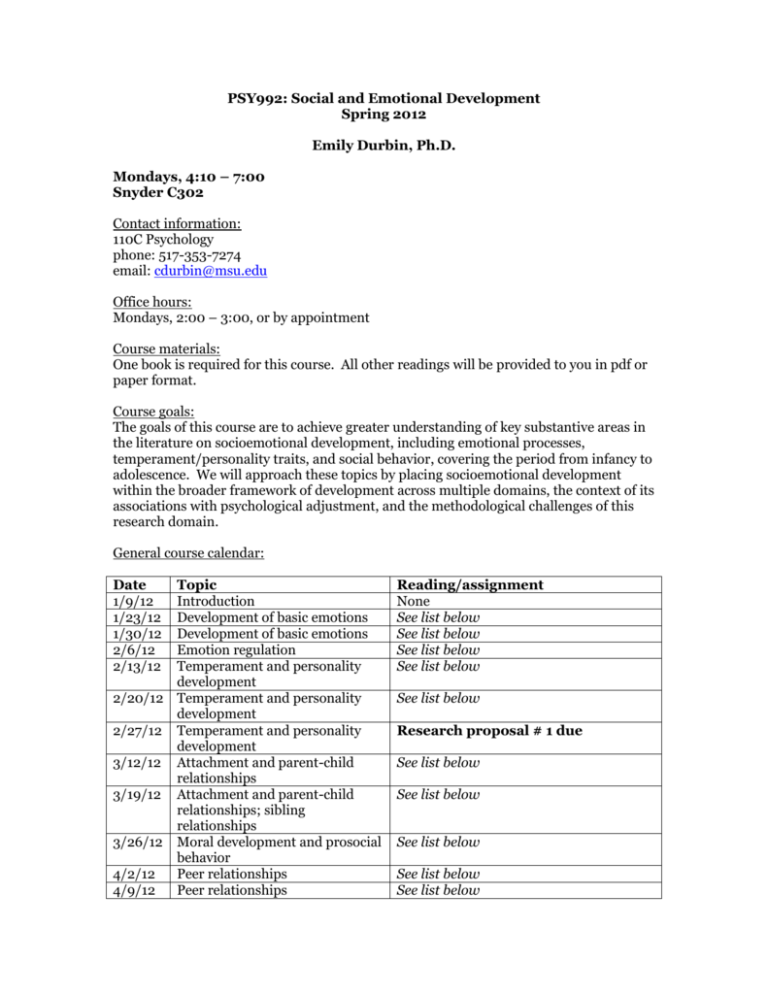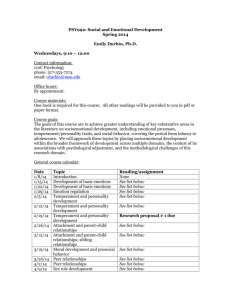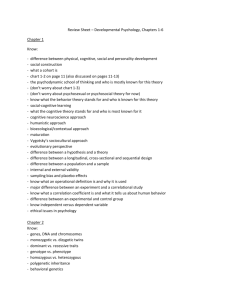PSY992: Social and Emotional Development Spring 2012 Emily
advertisement

PSY992: Social and Emotional Development Spring 2012 Emily Durbin, Ph.D. Mondays, 4:10 – 7:00 Snyder C302 Contact information: 110C Psychology phone: 517-353-7274 email: cdurbin@msu.edu Office hours: Mondays, 2:00 – 3:00, or by appointment Course materials: One book is required for this course. All other readings will be provided to you in pdf or paper format. Course goals: The goals of this course are to achieve greater understanding of key substantive areas in the literature on socioemotional development, including emotional processes, temperament/personality traits, and social behavior, covering the period from infancy to adolescence. We will approach these topics by placing socioemotional development within the broader framework of development across multiple domains, the context of its associations with psychological adjustment, and the methodological challenges of this research domain. General course calendar: Date 1/9/12 1/23/12 1/30/12 2/6/12 2/13/12 Topic Introduction Development of basic emotions Development of basic emotions Emotion regulation Temperament and personality development 2/20/12 Temperament and personality development 2/27/12 Temperament and personality development 3/12/12 Attachment and parent-child relationships 3/19/12 Attachment and parent-child relationships; sibling relationships 3/26/12 Moral development and prosocial behavior 4/2/12 Peer relationships 4/9/12 Peer relationships Reading/assignment None See list below See list below See list below See list below See list below Research proposal # 1 due See list below See list below See list below See list below See list below 4/16/12 4/23/12 Sex role development Play See list below Research proposal # 2 due Course readings: 1/9/12: none 1/23/12: Development of basic emotions Abe, J.A., & Izard, C.E. (1999). The developmental functions of emotions: An analysis in terms of differential emotions theory. Cognition and Emotion, 13(5), 523549. Izard, C.E., Fantauzzo, C.A., Castle, J.M., Haynes, M.O., Rayias, M.F., & Putnam, P.H. (1995). The ontogeny and significance of infants’ facial expressions in the first 9 months of life. Developmental Psychology, 31(6), 997-1013. Camras, L.A., Oster, H., Campos, J., Campos, R., Ujie, T., Miyake, K., Wang, L., & Meng, Z. (1998). Production of emotional facial expressions in European American, Japanese, and Chinese infants. Developmental Psychology, 34(4), 616-628. 1/30/12: Development of basic emotions Campos, J.J., Bertenthal, B.I., & Kermoian, R. (1992). Early experience and emotional development: The emergence of wariness of heights. Psychological Science, 3(1), 61-64. Widen, S.L., & Russell, J.A. (2003). A closer look at preschoolers’ freely produced labels for facial expressions. Developmental Psychology, 39(1), 114-128. emotion recognition paper. McClure, E.B. (2000). A meta-analytic review of sex differences in facial expression processing and their development in infants, children, and adolescents. Psychological Bulletin, 126(3), 424-453. Durbin, C.E., & Wilson. S. (in press). Convergent Validity of and Bias in Maternal Reports of Child Emotion. Psychological Assessment. 2/6/12: Emotion regulation Buss, K.A., & Kidd, E.J. (2004). Comparison of sadness, anger, and fear facial expressions when toddlers look at their mothers. Child Development, 75, 1761-1773. Buss, K.A., & Goldsmith, H.H. (1998). Fear and anger regulation in infancy: Effects on the temporal dynamics of affective expression. Child Development, 69(2), 359-374. Mangelsdorf, S.C., Shapiro, J.R., & Marzolf, D. (1995). Developmental and temperament differences in emotion regulation in infancy. Child Development, 66, 181701828. Larson, R.W., Moneta, G., Richards, M.H., & Wilson, S. (2002). Continuity, stability, and change in daily emotional experience across adolescence. Child Development, 73, 1151-1165. Hongwanishkul, D., Happaney, K.R., Lee, W.S.C., & Zelazo, P.D. (2005). Assessment of hot and cool executive function in young children: Age-related changes and individual differences. Developmental Neuropsychology, 28(2), 617-644. Ponitz, C.C., McClelland, M.M., Matthews, J.S., & Morrison, F.J. (2009). A structured observation of behavioral self-regulation and its contribution to kindergarten outcomes. Developmental Psychology, 45(3), 605-619. Campos, J.J., Frankel, C.B., & Camras, L. (2004). On the nature of emotion regulation. Child Development, 75(2), 377-394. 2/13/12: Temperament and personality development Rothbart, M.K., Ahadi, S.A., & Evans, D.E. (2000). Temperament and personality: Origins and outcomes. Journal of Personality and Social Psychology, 78, 122-135. Lemery, K.S., Goldsmith, H.H., Klinnert, M.D., & Mrazek, D.A. (1999). Developmental modesl of infant and childhood temperament. Developmental Psychology, 35(1), 189-204. John, O.P., Caspi, A., Robins, R.W., Moffitt, T.E., & Stouthamer-Lober, M. (1994). The “Little Five: Exploring the nomological network of the five-factor model of personality in adolescent boys. Child Development, 65, 160-178. Scarr, S., & McCartney, K. (1983). How people make their own environments: A theory of genotype-> environment effects. Child Development, 54, 424-435. 2/20/12: Temperament and personality development Abe, J.A., & Izard, C.E. (1999). A longitudinal study of emotion expression and personality relations in early development. Journal of Personality and Social Psychology, 77(3), 566-577. Block, J., & Block, J.H. (2006). Venturing a 30-year-longitudinal study. American Psychologist, 61(4), 315-327. Kremen, A.M., & Block, J. (1998). The roots of ego-control in young adulthood: Links with parenting in early childhood. Journal of Personality and Social Psychology, 75(4), 1062-1075. Caspi, A. (2000). The child is the father of the man: Personality continuities from childhood to adulthood. Journal of Personality and Social Psychology, 78, 158172. 2/27/12: Temperament and personality development Durbin, C.E., Hayden, E.P., Klein, D.N., & Olino, T.M. (2007). Stability of laboratory-assessed temperamental emotionality traits from ages 3 to 7. Emotion, 7(2), 388-399. Caspi, A., Roberts, B.W., & Shiner, R.L. (2005). Personality development: Stability and change. Annual Review of Psychology, 56, 453-484. McAdams, D.P., & Olson, B.D. (2010). Personality development: Continuity and change over the life course. Annual Review of Psychology, 61, 517-542. 3/12/12: Attachment and parent-child relationships Bowlby, J. (1982). Attachment (2nd edition). Basic Books: New York. Harlow, H.F. (1958). The nature of love. American Psychologist, 13, 573-685. 3/19/12: Attachment and parent-child relationships; sibling relationships Nachmias, M., Gunnar, M., Mangelsdorf, S., Parritz, R.H., & Buss, K. (1996). Behavioral inhibition and stress reactivity: The moderating role of attachment security. Child Development, 67, 508-522. Chen, X., Hastings, P.D., Rubin, K.H., Chen, H., Cen, G., & Stewart, S.L. (1998). Child-rearing attitudes and behavioral inhibition in Chinese and Canadian toddlers: A cross-cultural study. Developmental Psychology, 34, 677-686. Kochanska, G., Aksan, N., & Carlson, J.J. (2005). Temperament, relationships, and young children’s receptive cooperation with their parents. Developmental Psychology, 41, 648-660. Kochanksa, G., Aksan, N., Penney, S.J., & Boldt, L.J. (2007). Parental personality as an inner resource that moderates the impact of ecological adversity on parenting. Journal of Personality and Social Psychology, 92(1), 136-150. Maccoby, E.E. (1992). The role of parents in the socialization of children: An historical overview. American Psychologist, 45(4), 513-520. Fraley, R.C., & Shaver, P.R. (1998). Airport separations: A naturalistic study of adult attachment dynamics in separating couples. Journal of Personality and Social Psychology, 75(5), 1198-1212. Buhrmester, D., & Furman, W. (1990). Perceptions of sibling relationships during middle childhood and adolescence. Child Development, 61, 1387-1398. Dunn, J., Slomkowski, C., & Beardsall, L. (1994). Sibling relationships from the preschool period through middle childhood and early adolescence. Developmental Psychology, 30(3), 315-324. 3/26/12: Moral development and prosocial behavior Kochanska, G. (1997). Multiple pathways to conscience for children with different temperaments: From toddlerhood to age 5. Developmental Psychology, 33(2), 228-240. Kochanska, G., Gross, J.N., Lin, M.-H., & Nichols, K.E. (2002). Guilt in young children: Development, determinants, and relations within a broader system of standards. Child Development, 73(2), 461-482. Thompson, R.A. (2007). The development of the person: Social understanding, relationships, conscience, self. In The Handbook of Child Psychology, Volume 3 (6th edition). N. Eisenberg, W. Damon, R.M. Lerner (Eds). Wiley & Sons: Hoboken, NJ. 4/2/12: Peer relationships Parker, J.G., & Asher, S.R. (1993). Friendship and friendship quality in middle childhood: Links with peer group acceptance and feelings of loneliness and social dissatisfaction. Developmental Psychology, 29(4), 611-621. Benenson, J., Apostoleris, N., & Parnass, J. (1998). The organization of children’s same-sex peer relationships. New Directions for Child Development, 80, 523. Parker, J.G., Rubin, K.H., Erath, S.A., Wojslawowicz, J.C., & Buskirk, A.A. (2006). Peer relationships, child development, and adjustment: A developmental psychopathology perspective. In Developmental psychopathology, Vol 1: Theory and method (2nd ed.), D. Cicchetti & D.J. Cohen (Eds). Wiley & Sons: Hoboken, NJ. Richards, M.H., Crowe, R.A., Larson, R., & Swarr, A. (1998). Developmental patterns and gender differences in the experience of peer companionship during adolescence. Child Development, 69, 154-163. 4/9/12: Peer relationships Harris, J.R. (1995). Where is the child’s environment? A group socialization theory of development. Psychological Review, 102(3), 458-489. Rose, A.J., & Rudolph, K.D. (2006). A review of sex differences in peer relationship processes: Potential trade-offs for the emotional and behavioral development of girls and boys. Psychological Bulletin, 132(1), 98-131. Collins, W.A., Welsh, D.P., & Furman, W. (2009). Adolescent romantic relationships. Annual Review of Psychology, 60, 631-652. 4/16/12: Sex role development Maccoby, E.E. (1990). Gender and relationships: A developmental account. American Psychologist, 45(4), 513-520. Fabes, R.A., Martin, C.L., & Hanish, L. (2004). The next 50 years: Considering gender as a context for understanding young children’s peer relationships. MerrillPalmer Quarterly, 50(3), 260-273. Berenbaum, S.A., & Snyder, E. (1995). Early hormonal influences on childhood sex-typed activity and playmate preferences: Implications for the development of sexual orientation. Developmental Psychology, 31(1), 31-42. 4/23/12: Play Scott, E., & Panksepp, J. (2003). Rough-and-tumble play in human children. Aggressive Behavior, 29, 539-551. Larson, R.W., & Verma, S. (1999). How children and adolescents spend time across the world: Work, play, and developmental opportunities. Psychological Bulletin, 125(6), 701-736. Assignments and evaluations: Completion of assigned readings. You are expected to complete the material listed for each course meeting prior to that date so that you are prepared to discuss them. Discussion. I will use lectures to provide you with context for understanding and interpreting the assigned readings, but the primary vehicle for learning in this course will be our classroom discussions. You are expected to take an active part in these discussions. Written assignments. You will write 2 brief research proposals; one is due any time prior to spring break, and the second any time prior to finals week. The proposal will describe a research study designed to address a question related to socioemotional development, and will be written in the format of a grant proposal. Proposals are to be no longer than 7 single-spaced pages. Format guidelines will be provided to you in class. Evaluations contributing to your final grade: Attendance and discussion: Proposal # 1: Proposal # 2 30% 35% 35%








